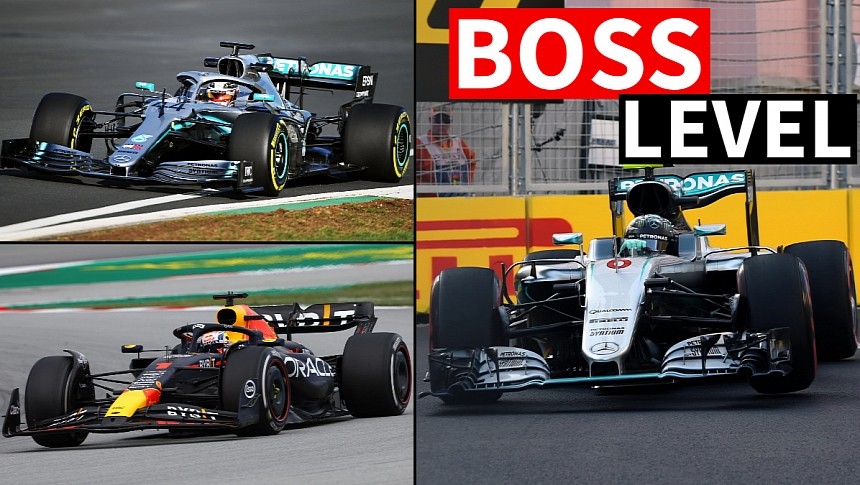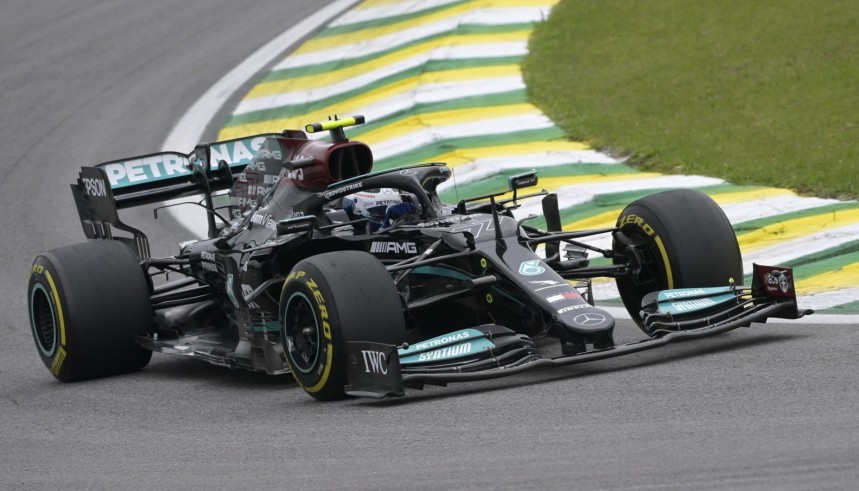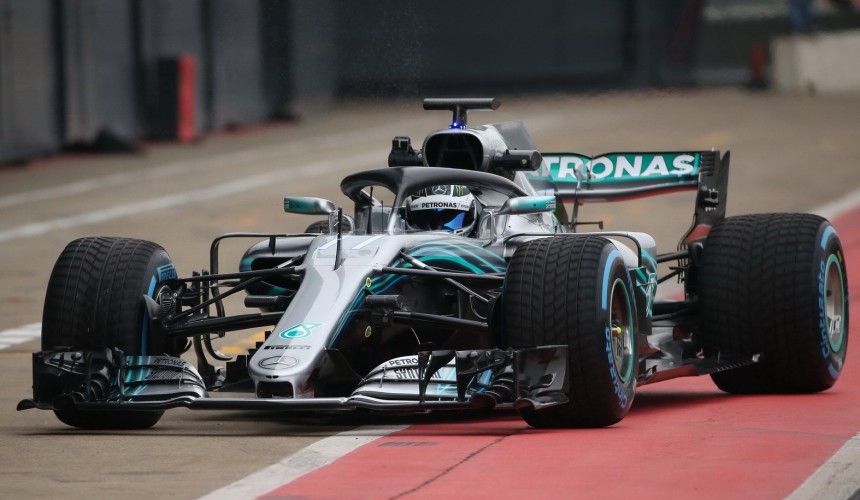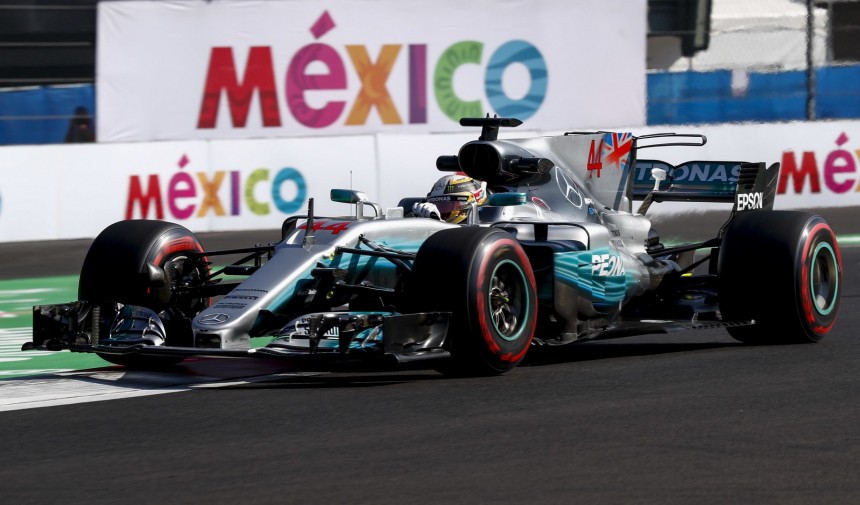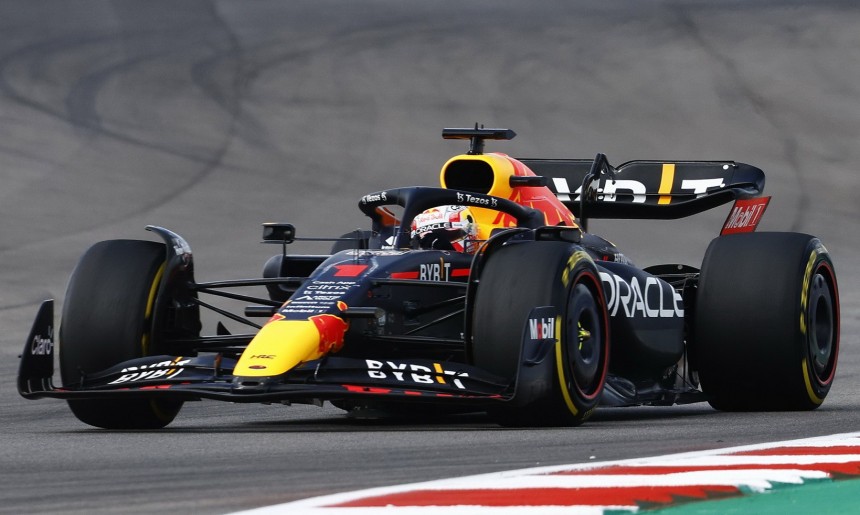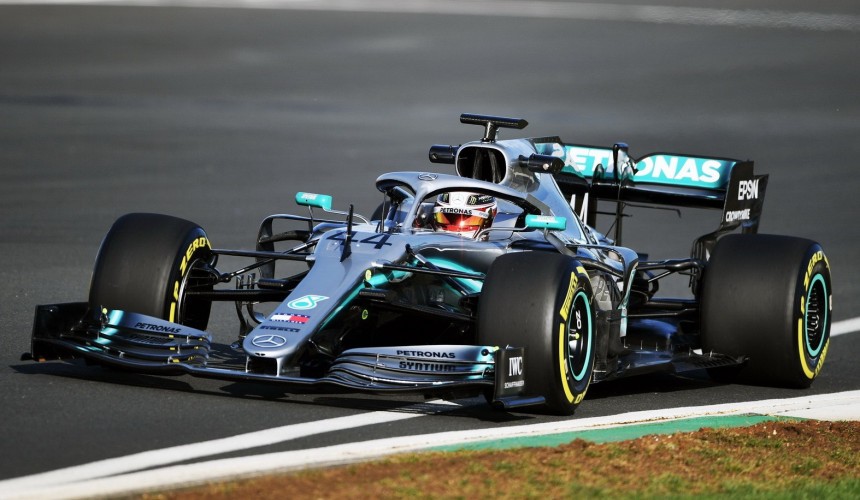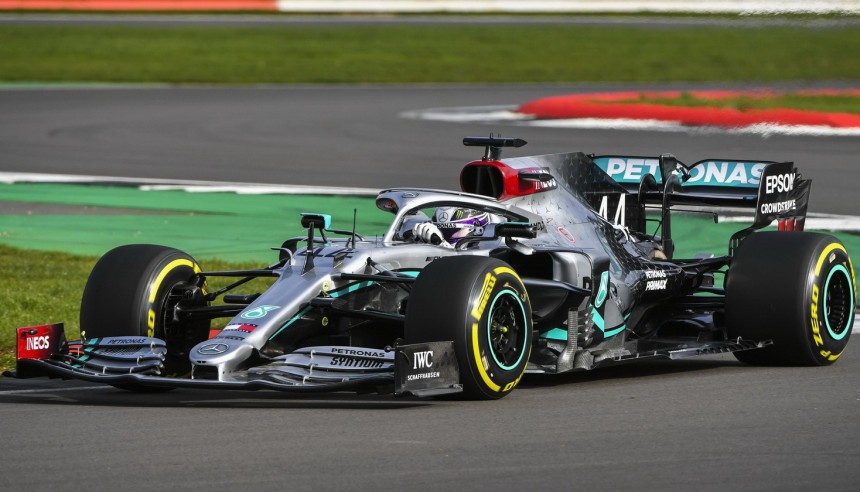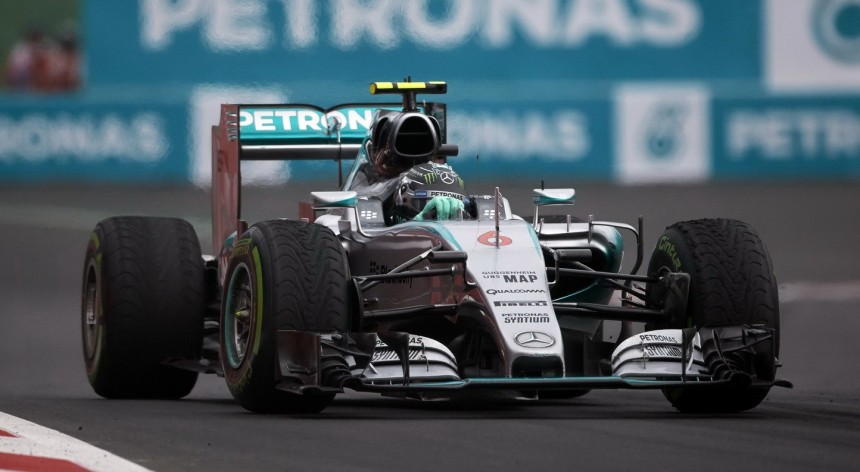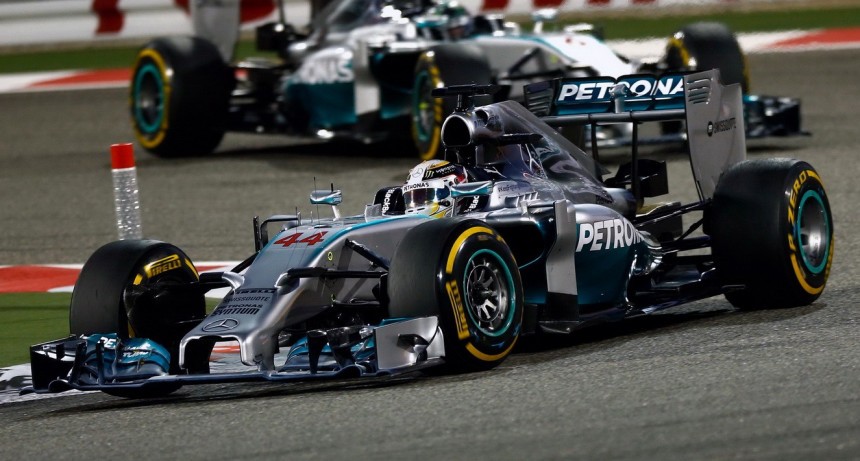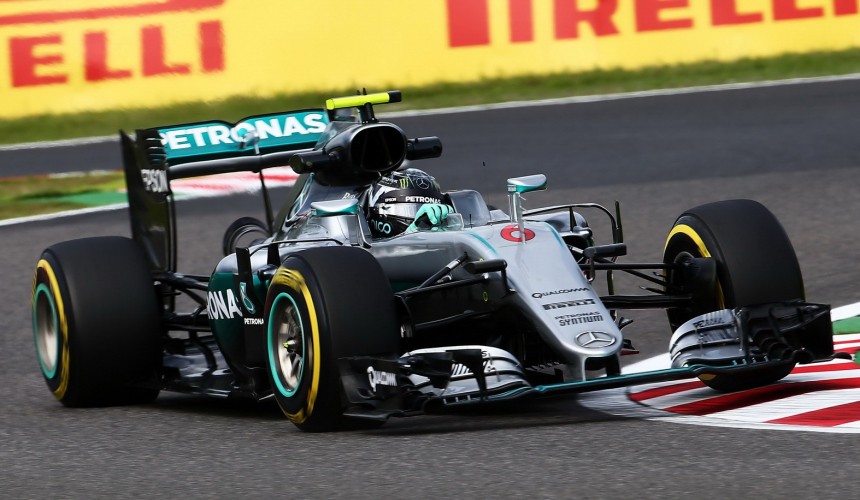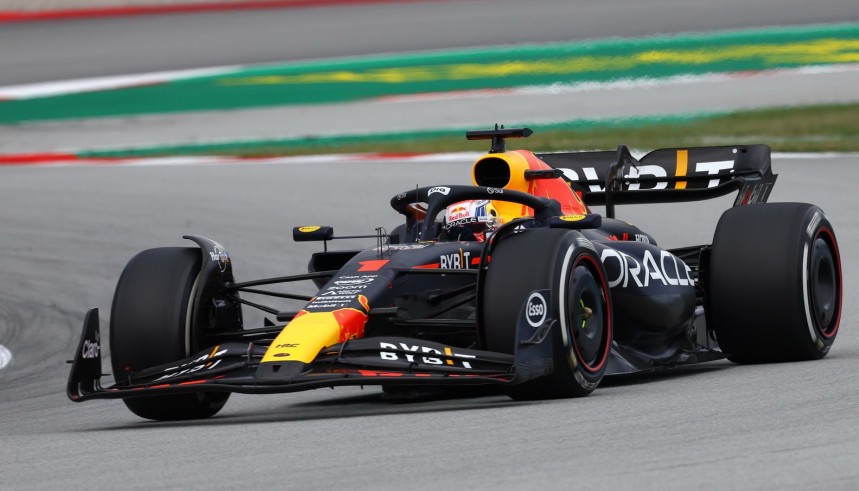Since F1 decided to switch from 2.4-liter V8 engines to these newer turbocharged 1.6-liter V6 hybrids, one might argue that we’ve seen less spectacular racing across the board, purely because of how dominant certain teams have been during this past decade.
[UPDATE] Now that the 2023 F1 season is concluded, we can finally give you our final rankings in terms of Best F1 cars from this current V6 hybrid era, and as expected, Red Bull's RB19 race car claims the top spot in a commanding fashion.
Switching to a smaller displacement is obviously not responsible for this. However, in combination with the MGU-K (formerly known as KERS), these drivetrains became downright tricky to get just right, to the point where whoever ended up building the best engine would simply tower over the opposition like Shaq staring down a bunch of fourth graders.
Think about this: from 2014 and up until today, we’ve only had two seasons in Formula 1 that were even remotely competitive as far as having two teams genuinely fight for the Constructors Title. It happened recently in 2021 when Mercedes-AMG edged out Red Bull for the Chip by just 28 points, and previously it happened in 2018 when the German outfit beat Ferrari by 84 points.
Every other year was a complete blowout. One could argue that Ferrari were pretty good in 2017 too, but in the end, they fell behind by 146 points to Mercedes, and that’s still a lot.
Regarding the hybrid part, the powers that be decided to use both an MGU-K system as well as MGU-H, the latter in charge of heat energy recovery. Right off the bat, Mercedes came out with the most powerful engine, with the rest of the grid playing catch-up for years to come.
Now that we’ve gotten that out of the way, let’s look at the very best F1 cars of the V6 turbo hybrid era and rank them according to how dominant they were. Yes, it’s all about dominance, and I’ve devised a simple formula that should tell us unequivocally which cars excelled most in that department.
The formula is this: Point Difference (to runner-up car) + Winning Percentage / 2 = DR (Dominance Rating).
I thought about using the total number of points too, but quickly realized they are irrelevant when thinking ‘Dominance’ - simply because some seasons featured more races than others, so teams would naturally rank up more points.
The Mercedes-AMG F1 W12 E Performance competed in the 2021 Formula 1 Championship, driven by Lewis Hamilton and Valtteri Bottas, in the latter’s last season with the outfit.
The W12 is dead-last on our list because it was the first Mercedes F1 car of the V6 turbo hybrid era which failed to win either of its drivers a title – it won the Constructors championship 28 points clear of Red Bull, but it was Max Verstappen that went on to win the Drivers Title that year, on that controversial final lap at Abu Dhabi. I can still hear Toto Wolff yelling in that garage.
So, what went wrong? Well, for starters, the FIA banned Mercedes’ DAS system, which the team used on the W11 that previous year. Don’t get me wrong though, this was not a poor car by any metrics. It just wasn’t as dominant as people expected, with some pointing to its compromised lower rake design for the floor.
Still, James Allison and his team did a solid job and Lewis Hamilton harnessed every single one of the W12’s 1,015 horsepower to win a total of 8 Grand Prix that year, including three in a row, before that dramatic Abu Dhabi finale. All in all, the car won 9 out of 22 races, amassing 613.5 points.
Designed under the watchful eye of Technical Director James Allison, the Mercedes-AMG F1 W09 EQ Power+ race car attended the 2018 F1 Championship, driven by Hamilton and Bottas, in only the latter’s second year at Mercedes.
This car ran through the field winning 11 races (all Hamilton), clinching the fifth consecutive Constructors title for Mercedes with one race to spare in the season. It all sounds mighty impressive, right? It was. However, the W09 didn’t utterly dominate the field. It finished the year with 655 points, 84 points clear of its nearest rival.
Its winning percentage was 52.38% - which will often put you in a position to win a title, but it’s certainly not as impressive as some of these next few cars. Anyway, second in the standings that year were Ferrari, with a pretty good car of their own, but ultimately, one that would fall short.
In terms of specs, the W09 was said to produce 1,000 horsepower while weighing just 1,616 lbs (733 kg).
Fun fact, George Russel, who back then was a Formula 2 driver, tested the W09 at the Hungaroring in 2018, setting a new lap record. You can bet that Toto Wolff took notice.
The Mercedes-AMG F1 W08 EQ Power+ race car was designed by Paddy Lowe and his team to compete in the 2017 F1 season with Hamilton and Bottas as the driver pairing. This was Bottas’ first year at Mercedes, in the wake of reigning champion Nico Rosberg retiring to become a YouTuber. Just teasing, it’s all love Nico.
The W08 won 12 out of 20 races (60%), scoring a total of 668 points to Ferrari’s 522. Hamilton was responsible for nine of those wins, while Bottas secured three. That was also the first year in which Mercedes used EQ Power+ in the nomenclature.
What really got things moving was a comprehensive upgrade package installed ahead of the Spanish Grand Prix that year. The car featured a narrower nose with a turning vane underneath. Other mods included bargeboards, winglets, new camera mounts, a revised floor and an upgraded rear wing.
Oh, and in case you didn’t know, the W08 was the first car that either Mercedes team boss Toto Wolff or Lewis Hamilton called “diva”. Both then went on to use this expression for subsequent models, but the W08 was the original, for what it’s worth. As for which of the two called it by that name first, I believe it was Wolff, not Hamilton.
Penned by F1 great Adrien Newey, the RB18 still stands as one of the most dominant cars in the history of Formula 1.
It competed in the 2022 championship, which Max Verstappen clinched convincingly for both him and his team. The RB18 finished the year with 759 points, 205 points ahead of Ferrari, who were second in the standings.
Now, while this car did win 17 of 22 races, things weren’t necessarily looking great for Red Bull in the beginning of the season. Not that they were doing poorly, but rather Ferrari seemed to have the quickest car out there for the first few races of 2022. Afterwards, we all know what happened and how the Scuderia dropped the ball, resulting in the dismissal of team principal Mattia Binotto.
Anyway, back to the RB18 – Sergio Perez, also looked strong behind the wheel in the first few GPs, but ultimately nobody could stand in the way of Max Verstappen, who simply proved too good at extracting every single ounce of performance from this race car.
The RB18 will surely go down in history as one of the greatest Red Bull F1 cars ever built. By the end of last season, it looked damn near invincible, and with Ferrari out of the picture (in terms of development), there really was no stopping this train.
Another one of James Allison’s successful designs came about in the Mercedes-AMG F1 W10 EQ Power+ racer, driven by Lewis Hamilton and Valtteri Bottas in 2019. This beast of a car won 15 out of 21 Grand Prix, with Hamilton claiming 11 of those, and Bottas four.
The pair also split ten pole positions between them (down the middle), nine fastest laps, seven front-row lockouts and nine 1-2 tandem finishes. The W10 also helped land Mercedes its sixth consecutive Constructors title, something only Scuderia Ferrari had previously pulled off (1999-2004).
Right off the bat, this car flexed its strength in low and mid-speed corners. Some cooling issues did arise later in the season, but it was nothing that Mercedes’ engineers couldn’t handle.
Keep in mind, the W10 was thought to be less powerful than Ferrari’s 2019 challenger, the ‘064’, and yet there was no stopping it when the lights turned green. Also, visually, this happens to be one of Mercedes’ best-looking race cars from the past decade. Feel free to contradict though.
The W10 ended the year with 739 points to Ferrari’s 504 and would go on to lay the groundwork for its successor, which just happens to be the very next car we’ll be talking about.
Mercedes followed up an incredibly strong 2019 F1 season with yet another banger of a year, thanks to the sublime W11 EQ Performance race car – yes, this is the one that got updated to an all-black livery, which let’s face it, looked absolutely smashing.
Now, despite its success, the W11 did know controversy, as James Allison and his team decided to implement a new system called DAS (Dual Axis Steering). This technology allowed Lewis Hamilton and Valtteri Bottas to adjust the toe of the front wheels by pulling/pushing on the steering wheel. In turn, this led to the tires warming up more efficiently, as well as improved cornering ability.
You’ll probably remember that the W11 was nothing short of breathtaking on circuits with long straights, and a lot of it had to do with the DAS system.
In terms of achievements, the W11 won 13 of 17 races (this was a shortened season, because of COVID), to go with 15 pole positions (ten Hamilton / five Bottas), nine fastest laps, twelve front-row lockouts and five 1-2 finishes.
By breaking a record for consecutive Constructors titles (held by Ferrari), the Mercedes W11 is rightfully considered to be one of the greatest Formula 1 race cars in the history of the sport. Had the season been longer, it may have proven to be even more dominant, which would have landed it higher on this list. Still, nothing wrong with no.5.
Built under the direction of Paddy Lowe specifically to compete in the 2015 Formula 1 season, the Mercedes F1 W06 Hybrid is the sequel to the incredibly successful W05, the latter being one of the most dominant race cars in F1 history.
Rest assured that the W06 did its job well too, with reigning world champion Lewis Hamilton and Nico Rosberg in charge of putting all that performance to good use.
Lowe made sure not to change a lot of things as far as the W06 was concerned, so that they wouldn’t stray from the accomplishments of the W05. Even Hamilton once admitted that it was difficult to notice any differences between the two in terms of how they drove. Visually though, there were minor changes, most notably the nose, front wing and the upper part of the suspension.
When the clock struck midnight for the end of the 2015 season, the W06 had amassed 16 wins in 19 races, 32 podiums, 18 poles (eleven Hamilton, seven Rosberg) and 13 fastest laps. Its total number of points was 703 to Ferrari’s 428 – a 275-point difference is pretty darn sizable.
Mercedes also lost just 114 points across the entire season, meaning they secured 86% of all points available, which statistically is just on a whole different level. Still, in terms of sheer dominance, believe it or not, we still have three cars that will outshine the W06.
We’re in the endgame now, as Dr. Strange once said at the end of Infinity War. For us, this means the Top 3, reserved for F1 cars with God-like results and performance – cars that have separated themselves from the rest of the field to the point where you could just attribute a win to them without even going racing.
The Mercedes W05 Hybrid is one such race car, created under the supervision of Bob Bell and his team to compete in the 2014 F1 season.
With Lewis Hamilton and Nico Rosberg behind the wheel, the W05, which by the way was the first Mercedes Grand Prix car of the hybrid era, demolished the competition on its way to winning 16 of 19 events, putting 296 points between itself and that year’s next best car, which was a Red Bull.
Other statistical highlights for the W05, which Hamilton once called the “best car he’s ever driven”, include a total of 31 podiums, 18 poles and 12 fastest laps.
What made the W05 so dominant, you ask? It is believed that its powertrain featured an innovative packaging design, where the compressor and the turbo were located at opposite ends of the internal combustion unit. This led to more efficient aerodynamics and battery usage.
It’s almost hard to imagine the hybrid era having two cars that kicked even more behind than the W05, but alas, it did... and does!
Paddy Lowe’s creation for the 2016 season surpassed all expectations. This was the car that won Nico Rosberg his title, and together with Lewis Hamilton, the two secured 765 points for the year, 297 points clear of Red Bull. They won 19 out of 21 races, for a winning percentage of 90.48%.
They also scored 33 podiums, 20 poles and 9 fastest laps – and all this in a car that technically wasn’t as reliable as some of its predecessors/successors. The W07 would often get off to poor starts off the line (clutch issues), while the power unit itself would also sometimes act up.
Bottom line, the Mercedes W07 overcame the odds and pulled off a miracle of a season, hitting amazing highs and securing its place among all-time great F1 cars for the rest of time.
This car, built by Adrian Newey and raced by Max Verstappen and Sergio Perez, confirmed its pace straight away, unlike the RB18 which engaged in a battle with Ferrari for the first few Grand Prix last year.
Past the midway point of this season, the RB19 was already worthy of being in the conversation for the most dominant car of its era, if not all time. At that point, we thought that Red Bull could finish the 2023 F1 season unbeaten, which would have technically made the RB19 not only the greatest car of its generation, but the greatest F1 race car of all time. No other team has ever won 100% of their races – McLaren came closest in 1988 with Senna and Prost, winning all but one.
Now, while the RB19 didn't go undefeated, it did win 21 of 23 races, amassing a total of 860 points in the Constructor's Standings, whereas second-place Mercedes could only manage 409 points. That's an incredible difference, and it's why the RB19's Dominance Rating is so ridiculously high.
Aside from securing 21 wins, this car also claimed 30 podiums, 14 poles and 11 fastest laps. It is without a doubt the single greatest Formula 1 car of the V6 turbo hybrid era.
Switching to a smaller displacement is obviously not responsible for this. However, in combination with the MGU-K (formerly known as KERS), these drivetrains became downright tricky to get just right, to the point where whoever ended up building the best engine would simply tower over the opposition like Shaq staring down a bunch of fourth graders.
Think about this: from 2014 and up until today, we’ve only had two seasons in Formula 1 that were even remotely competitive as far as having two teams genuinely fight for the Constructors Title. It happened recently in 2021 when Mercedes-AMG edged out Red Bull for the Chip by just 28 points, and previously it happened in 2018 when the German outfit beat Ferrari by 84 points.
Every other year was a complete blowout. One could argue that Ferrari were pretty good in 2017 too, but in the end, they fell behind by 146 points to Mercedes, and that’s still a lot.
Why turbo hybrids?
The gist of it was this – the FIA decided to go with 1.6-liter V6 hybrids and wouldn’t allow forced induction, which meant that teams had to decide between using a turbocharger or a supercharger. They obviously went with the former, seeing as how turbocharging is more efficient at creating boost than supercharging, and in F1, efficiency is the key to all things.Regarding the hybrid part, the powers that be decided to use both an MGU-K system as well as MGU-H, the latter in charge of heat energy recovery. Right off the bat, Mercedes came out with the most powerful engine, with the rest of the grid playing catch-up for years to come.
Now that we’ve gotten that out of the way, let’s look at the very best F1 cars of the V6 turbo hybrid era and rank them according to how dominant they were. Yes, it’s all about dominance, and I’ve devised a simple formula that should tell us unequivocally which cars excelled most in that department.
The formula is this: Point Difference (to runner-up car) + Winning Percentage / 2 = DR (Dominance Rating).
I thought about using the total number of points too, but quickly realized they are irrelevant when thinking ‘Dominance’ - simply because some seasons featured more races than others, so teams would naturally rank up more points.
10. Mercedes W12 (34.4 DR)
The W12 is dead-last on our list because it was the first Mercedes F1 car of the V6 turbo hybrid era which failed to win either of its drivers a title – it won the Constructors championship 28 points clear of Red Bull, but it was Max Verstappen that went on to win the Drivers Title that year, on that controversial final lap at Abu Dhabi. I can still hear Toto Wolff yelling in that garage.
So, what went wrong? Well, for starters, the FIA banned Mercedes’ DAS system, which the team used on the W11 that previous year. Don’t get me wrong though, this was not a poor car by any metrics. It just wasn’t as dominant as people expected, with some pointing to its compromised lower rake design for the floor.
Still, James Allison and his team did a solid job and Lewis Hamilton harnessed every single one of the W12’s 1,015 horsepower to win a total of 8 Grand Prix that year, including three in a row, before that dramatic Abu Dhabi finale. All in all, the car won 9 out of 22 races, amassing 613.5 points.
9. Mercedes W09 (68.1 DR)
This car ran through the field winning 11 races (all Hamilton), clinching the fifth consecutive Constructors title for Mercedes with one race to spare in the season. It all sounds mighty impressive, right? It was. However, the W09 didn’t utterly dominate the field. It finished the year with 655 points, 84 points clear of its nearest rival.
Its winning percentage was 52.38% - which will often put you in a position to win a title, but it’s certainly not as impressive as some of these next few cars. Anyway, second in the standings that year were Ferrari, with a pretty good car of their own, but ultimately, one that would fall short.
In terms of specs, the W09 was said to produce 1,000 horsepower while weighing just 1,616 lbs (733 kg).
Fun fact, George Russel, who back then was a Formula 2 driver, tested the W09 at the Hungaroring in 2018, setting a new lap record. You can bet that Toto Wolff took notice.
8. Mercedes W08 (103 DR)
The W08 won 12 out of 20 races (60%), scoring a total of 668 points to Ferrari’s 522. Hamilton was responsible for nine of those wins, while Bottas secured three. That was also the first year in which Mercedes used EQ Power+ in the nomenclature.
What really got things moving was a comprehensive upgrade package installed ahead of the Spanish Grand Prix that year. The car featured a narrower nose with a turning vane underneath. Other mods included bargeboards, winglets, new camera mounts, a revised floor and an upgraded rear wing.
Oh, and in case you didn’t know, the W08 was the first car that either Mercedes team boss Toto Wolff or Lewis Hamilton called “diva”. Both then went on to use this expression for subsequent models, but the W08 was the original, for what it’s worth. As for which of the two called it by that name first, I believe it was Wolff, not Hamilton.
7. Red Bull Racing RB18 (141 DR)
It competed in the 2022 championship, which Max Verstappen clinched convincingly for both him and his team. The RB18 finished the year with 759 points, 205 points ahead of Ferrari, who were second in the standings.
Now, while this car did win 17 of 22 races, things weren’t necessarily looking great for Red Bull in the beginning of the season. Not that they were doing poorly, but rather Ferrari seemed to have the quickest car out there for the first few races of 2022. Afterwards, we all know what happened and how the Scuderia dropped the ball, resulting in the dismissal of team principal Mattia Binotto.
Anyway, back to the RB18 – Sergio Perez, also looked strong behind the wheel in the first few GPs, but ultimately nobody could stand in the way of Max Verstappen, who simply proved too good at extracting every single ounce of performance from this race car.
The RB18 will surely go down in history as one of the greatest Red Bull F1 cars ever built. By the end of last season, it looked damn near invincible, and with Ferrari out of the picture (in terms of development), there really was no stopping this train.
6. Mercedes W10 (153.2 DR)
The pair also split ten pole positions between them (down the middle), nine fastest laps, seven front-row lockouts and nine 1-2 tandem finishes. The W10 also helped land Mercedes its sixth consecutive Constructors title, something only Scuderia Ferrari had previously pulled off (1999-2004).
Right off the bat, this car flexed its strength in low and mid-speed corners. Some cooling issues did arise later in the season, but it was nothing that Mercedes’ engineers couldn’t handle.
Keep in mind, the W10 was thought to be less powerful than Ferrari’s 2019 challenger, the ‘064’, and yet there was no stopping it when the lights turned green. Also, visually, this happens to be one of Mercedes’ best-looking race cars from the past decade. Feel free to contradict though.
The W10 ended the year with 739 points to Ferrari’s 504 and would go on to lay the groundwork for its successor, which just happens to be the very next car we’ll be talking about.
5. Mercedes W11 (165.2 DR)
Now, despite its success, the W11 did know controversy, as James Allison and his team decided to implement a new system called DAS (Dual Axis Steering). This technology allowed Lewis Hamilton and Valtteri Bottas to adjust the toe of the front wheels by pulling/pushing on the steering wheel. In turn, this led to the tires warming up more efficiently, as well as improved cornering ability.
You’ll probably remember that the W11 was nothing short of breathtaking on circuits with long straights, and a lot of it had to do with the DAS system.
In terms of achievements, the W11 won 13 of 17 races (this was a shortened season, because of COVID), to go with 15 pole positions (ten Hamilton / five Bottas), nine fastest laps, twelve front-row lockouts and five 1-2 finishes.
By breaking a record for consecutive Constructors titles (held by Ferrari), the Mercedes W11 is rightfully considered to be one of the greatest Formula 1 race cars in the history of the sport. Had the season been longer, it may have proven to be even more dominant, which would have landed it higher on this list. Still, nothing wrong with no.5.
4. Mercedes W06 (179.6 DR)
Rest assured that the W06 did its job well too, with reigning world champion Lewis Hamilton and Nico Rosberg in charge of putting all that performance to good use.
Lowe made sure not to change a lot of things as far as the W06 was concerned, so that they wouldn’t stray from the accomplishments of the W05. Even Hamilton once admitted that it was difficult to notice any differences between the two in terms of how they drove. Visually though, there were minor changes, most notably the nose, front wing and the upper part of the suspension.
When the clock struck midnight for the end of the 2015 season, the W06 had amassed 16 wins in 19 races, 32 podiums, 18 poles (eleven Hamilton, seven Rosberg) and 13 fastest laps. Its total number of points was 703 to Ferrari’s 428 – a 275-point difference is pretty darn sizable.
Mercedes also lost just 114 points across the entire season, meaning they secured 86% of all points available, which statistically is just on a whole different level. Still, in terms of sheer dominance, believe it or not, we still have three cars that will outshine the W06.
3. Mercedes W05 (190.1 DR)
The Mercedes W05 Hybrid is one such race car, created under the supervision of Bob Bell and his team to compete in the 2014 F1 season.
With Lewis Hamilton and Nico Rosberg behind the wheel, the W05, which by the way was the first Mercedes Grand Prix car of the hybrid era, demolished the competition on its way to winning 16 of 19 events, putting 296 points between itself and that year’s next best car, which was a Red Bull.
Other statistical highlights for the W05, which Hamilton once called the “best car he’s ever driven”, include a total of 31 podiums, 18 poles and 12 fastest laps.
What made the W05 so dominant, you ask? It is believed that its powertrain featured an innovative packaging design, where the compressor and the turbo were located at opposite ends of the internal combustion unit. This led to more efficient aerodynamics and battery usage.
It’s almost hard to imagine the hybrid era having two cars that kicked even more behind than the W05, but alas, it did... and does!
2. Mercedes W07 (193.7 DR)
They also scored 33 podiums, 20 poles and 9 fastest laps – and all this in a car that technically wasn’t as reliable as some of its predecessors/successors. The W07 would often get off to poor starts off the line (clutch issues), while the power unit itself would also sometimes act up.
Bottom line, the Mercedes W07 overcame the odds and pulled off a miracle of a season, hitting amazing highs and securing its place among all-time great F1 cars for the rest of time.
1. Red Bull Racing RB19 (271.1 DR)
Past the midway point of this season, the RB19 was already worthy of being in the conversation for the most dominant car of its era, if not all time. At that point, we thought that Red Bull could finish the 2023 F1 season unbeaten, which would have technically made the RB19 not only the greatest car of its generation, but the greatest F1 race car of all time. No other team has ever won 100% of their races – McLaren came closest in 1988 with Senna and Prost, winning all but one.
Now, while the RB19 didn't go undefeated, it did win 21 of 23 races, amassing a total of 860 points in the Constructor's Standings, whereas second-place Mercedes could only manage 409 points. That's an incredible difference, and it's why the RB19's Dominance Rating is so ridiculously high.
Aside from securing 21 wins, this car also claimed 30 podiums, 14 poles and 11 fastest laps. It is without a doubt the single greatest Formula 1 car of the V6 turbo hybrid era.
